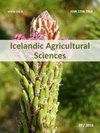冰岛西南部石南大黄蜂(Bombus jonellus)饲料植物的个案研究
IF 0.2
4区 农林科学
Q4 AGRICULTURE, MULTIDISCIPLINARY
引用次数: 1
摘要
大黄蜂(Bombus spp.)是一种具有高度保护价值的传粉昆虫。它们的行为(采集花粉、蜂鸣式授粉)、形态结构(适合保存花粉的分支体毛)和吸热能力,使它们非常适合在亚北极地区运输大量花粉(Heinrich & Vogt 1993, De Luca & Vallejo-Marín 2013)。最近的研究结果表明,欧洲23.6%的大黄蜂物种面临灭绝的威胁,45.6%的欧洲大黄蜂物种正在减少(Nieto et al. 2014)。这些下降可能是由于多种威胁协同作用,但主要威胁是觅食和筑巢资源的损失和碎片化(Kosior等人,2007年,Potts等人,2010年,Goulson等人,2015年)。在冰岛,入侵的非本地植物物种,如卢特卡羽豆(Lupinus nootkatensis Donn)和牛欧芹(Anthriscus sylvestris L.) (Magnússon 2011,冰岛自然历史研究所2016)的积极传播对本地牧草植物群落构成了严重威胁。最近的研究表明,由于入侵植物种群的扩散,冰岛唯一的本土蜜蜂,健康大黄蜂(B. jonellus Kirby)在冰岛面临严重下降的风险(Willow 2016)。为了保护冰岛的jonellus,我们不仅需要管理入侵植物物种,还需要提高我们对jonellus所访问的本地食用植物的认识(Willow 2016)。冰岛jonellus使用的开花植物种类的范围见Prŷs-Jones等人(1981,2016),并对其作为饲料资源的重要性进行了估计。然而,由于整个冰岛的植物传粉媒介网络正在发生变化,特别是由于入侵植物种群的传播和外来大黄蜂物种的引入(Magnússon 2011, Iceland Institute of Natural History 2016, Prŷs-Jones et al. 2016),因此需要进一步系统地观察觅食偏好。本研究的主要目的是确定在冰岛西南部相对自然的环境中,不同植物物种在整个牧草季节作为jonellus的饲料的意义。根据观察到的jonellus来访次数估计了每种饲料植物的重要性。本文章由计算机程序翻译,如有差异,请以英文原文为准。
Case study on forage plants of the heath bumblebee (Bombus jonellus) in southwest Iceland
INTRODUCTION Bumblebees (Bombus spp.) are pollinators of especially high conservation interest. They have behaviours (pollen-gathering, buzz pollination), morphological structures (branched body hairs well-adapted for retaining pollen), and endothermic capabilities, that make them welladapted for transporting large amounts of pollen in subarctic regions (Heinrich & Vogt 1993, De Luca & Vallejo-Marín 2013). Recent findings indicate that 23.6% of bumblebee species in Europe are threatened with extinction, and that 45.6% of Europe’s bumblebee species are in decline (Nieto et al. 2014). These declines are likely due to multiple threats acting synergistically, but the primary threat is the loss and fragmentation of foraging and nesting resources (Kosior et al. 2007, Potts et al. 2010, Goulson et al. 2015). In Iceland, the aggressive spread of invasive non-native plant species such as Nootka lupine (Lupinus nootkatensis Donn) and cow parsley (Anthriscus sylvestris L.) (Magnússon 2011, Icelandic Institute of Natural History 2016) represents a serious threat to native forage-plant communities. Recent research suggests that Iceland’s only native bee, the heath bumblebee (B. jonellus Kirby), is at risk of serious declines in Iceland due to the spread of invasive plant populations (Willow 2016). To protect B. jonellus in Iceland, we need to not only manage invasive plant species, but also improve our knowledge of the native food plants that B. jonellus visits (Willow 2016). A range of flowering plant species used by B. jonellus in Iceland is given in Prŷs-Jones et al. (1981, 2016), with estimates of their significance as forage resources. However, further systematic observations of foraging preferences are required, as the plant-pollinator network throughout Iceland is undergoing changes, particularly due to the spread of invasive plant populations and the introduction of exotic bumblebee species (Magnússon 2011, Icelandic Institute of Natural History 2016, Prŷs-Jones et al. 2016). The primary aim of this study was to determine the significance of various plant species, across the forage season, as forage for B. jonellus in relatively natural environments in south-west Iceland. The importance of each forage plant species was estimated from the number of observed B. jonellus visits.
求助全文
通过发布文献求助,成功后即可免费获取论文全文。
去求助
来源期刊

Icelandic Agricultural Sciences
AGRICULTURE, MULTIDISCIPLINARY-
CiteScore
0.80
自引率
0.00%
发文量
0
审稿时长
>12 weeks
期刊介绍:
Icelandic Agricultural Sciences is published annually, or more frequently. The deadline for submitting manuscripts that are intended to appear within that year is September. The journal is in English and is refereed and distributed internationally. It publishes original articles and reviews written by researchers throughout the world on any aspect of applied life sciences that are relevant under boreal, alpine, arctic or subarctic conditions. Relevant subjects include e.g. any kind of environmental research, farming, breeding and diseases of plants and animals, hunting and fisheries, food science, forestry, soil conservation, ecology of managed and natural ecosystems, geothermal ecology, etc.
 求助内容:
求助内容: 应助结果提醒方式:
应助结果提醒方式:


